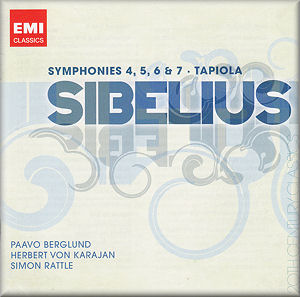|


alternatively
CD: MDT
AmazonUK
AmazonUS
|
Jean SIBELIUS (1865-1957)
Symphony No. 4 in A minor, Op.63 [39:06]
Symphony No. 5 in E flat, Op.82 [30:06]
Symphony No. 6 in D minor, Op.104 [27:19]
Symphony No. 7 in C major, Op.105 [21:30]
Tapiola, Op.112 [19:25]
 Berlin Philharmonic/Herbert von Karajan (Op.63, Op. 104, Op.112);
City of Birmingham Symphony Orchestra/Sir Simon Rattle (Op.82);
Helsinki Philharmonic Orchestra/Paavo Berglund (Op.105)
Berlin Philharmonic/Herbert von Karajan (Op.63, Op. 104, Op.112);
City of Birmingham Symphony Orchestra/Sir Simon Rattle (Op.82);
Helsinki Philharmonic Orchestra/Paavo Berglund (Op.105)
rec. 27-28 December 1976, Philharmonie, Berlin (Op. 63); 21 February
1987 Butterworth Hall, Warwick Arts Centre, University of Warwick,
Coventry (Op.82);
16-20 November 1980, Philharmonie, Berlin (Op.104); February 1984
All Saints Church, Tooting, London (Op.105); 28-29 December 1976,
Philharmonie, Berlin (Op.112)
 EMI CLASSICS 9 07246 2 [69:43 + 68:21]
EMI CLASSICS 9 07246 2 [69:43 + 68:21] 
|
This Sibelius set is the sixth release in EMI’s 20th-Century
Classics series. These double CD sets are intended to demonstrate
the range and quality rare and popular twentieth-century recordings
from the cavernous EMI Classics and Virgin Classics catalogues.
The composers range from Elgar to Ligeti, from Vaughan Williams
to Tcherepnin and from Rodrigo to Xenakis.
The present set consists of well chosen accounts of Sibelius’s
last four symphonies composed 1911-24 and the tone poem Tapiola.
Karajan and the Berlin Phil play the Symphonies 4 and 6 and
Tapiola. Incidentally of the many recordings Karajan
made of Sibelius symphonies he never tackled the Third whether
on record or in concert (see
review). Karajan’s Symphony No. 4 is remarkable for
its great strength and grandeur. The opening movement is especially
bleak and shadowy bordering on the mysterious. The Berlin brass
contributions are stunning. Overall the vast resources of strength
and energy that Karajan brings to the Symphony No. 6 are
impressive. I was struck by the sense of serenity in the Allegretto
moderato and the Scherzo gallops along relentlessly
drawing on seemingly immense reserves of energy. Sensibly paced
Karajan’s Tapiola is an account of gripping emotional
tension. One can almost hear the nature sounds and feel the
icy chill of Nordic forests.
From their complete set of the Sibelius symphonies Sir Simon
Rattle and the CBSO provide the account of the Symphony No.
5. I was immediately struck by its rangy and expansive qualities.
The opening movement is full of restlessness and pent-up anxiety.
The second movement, depicting a Nordic landscape, is remarkable
for glorious string playing although every section of the orchestra
excels. In the closing movement the music gains in weight and
movement and delivers a shattering climax.
The final symphony is heard from Paavo Berglund and the Helsinki
Philharmonic Orchestra. This recording forms part of Berglund’s
second complete set (review).
His opening Adagio has weight and astonishing grandeur.
A chill wind gusts in the Un pochettino meno adagio.
Later with the rapt tenderness of the string playing one could
be huddled over a log fire sheltering from the cold. Overall
Berglund’s interpretation is fresh, well paced and highly satisfactory.
Sibelius’s symphonies are extremely well served in the catalogue.
There are a considerable number of excellent competing accounts.
All of the following sets have been commended and have provided
me with much listening pleasure: Sir John Barbirolli/Hallé/EMI
Classics, Vladimir Ashkenazy/Philharmonia/Decca,
Sir Colin Davis/LSO/LSO Live, Sir Colin Davis/LSO/RCA
Red Seal, Osmo Vänskä/Lahti Symphony Orchestra/BIS
(soon to reappear as part of the Bis Edition alongside many
fascinating alternative movements and episodes), Sir Simon Rattle/CBSO/EMI,
Leif Segerstam/Helsinki Philharmonic Orchestra (Ondine) and
Leif Segerstam/Danish NSO/Brilliant
Classics (originally Chandos).
Karajan provides an alternative set of Nos. 4-7 and
Tapiola that warrants consideration. These are Karajan’s
earlier and much acclaimed accounts with the Berlin Philharmonic
from 1965-67 at the Jesus Christ Church, Berlin. They are available
as part of a double set in ‘The Originals’ series on Deutsche
Grammophon on 457
748-2 (c/w The Swan of Tuonela).
Good as these performances are I would be mystified why anyone
would want to purchase this two disc collection of Sibelius’s
last four symphonies and Tapiola from three different
conductors and three different orchestras when it is easy to
find an excellent complete set for just a few pounds more.
Michael Cookson
|

